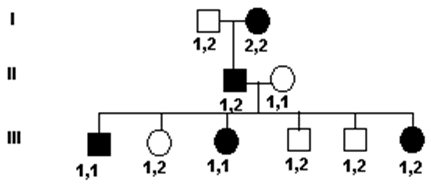1- Sickle-cell disease is the result of a single nucleotide substitution that produces a single amino acid substitution. This is best described as a?
2- Which of the following is not true of imprinting?
3- What is a likely explanation for the high prevalence of cystic fibrosis in European populations?
4- In one form of familial isolated growth hormone deficiency, deletion of an exon of a gene on chromosome 17 alters the protein product. In heterozygotes, this protein product then binds with the normal protein product encoded by the normal copy of the gene on chromosome 17, disabling the normal growth hormone molecule. This is best described as an example of?
5- Which of the following characterize adult polycystic kidney disease?
6- The mutation that causes Huntington disease is best described as?
7- Which of the following is not a characteristic of hemochromatosis?
8- A phenotypically normal woman has had two children with trisomy 13. Which of the following scenarios would be least likely to result in this recurrence?
9- Which of the following is not a feature of Down syndrome?
10- Uniparental disomy in a live birth is caused by which of the following mechanisms?
11- X inactivation?
1- A 30-year-old woman is phenotypically normal but had a brother who died from infantile Tay-Sachs disease (autosomal recessive lethal condition with 100% penetrance). What is the probability that this woman is a heterozygous carrier for TaySachs disease?.
2- A phenotypically normal couple with negative family history produces four children, three of whom have Marfan syndrome (autosomal dominant). What is the most likely explanation for this?.
3- You have been called as an expert witness in the J.O. Sampson case. J.O. is accused of shoplifting a scalpel from a medical supply store. The shoplifter clumsily cut himself (herself) while stealing the scalpel, leaving a drop of blood at the scene of the crime. Mr. Sampson was typed for one VNTR locus and was found to have alleles 3 and 5 of this system. The blood sample was typed and was found to match J.O. for these two alleles. The frequencies of these alleles in the general population are 0.05 and 0.10. What is the probability that somebody in the general population would match the blood sample?.
4- Two years later, the Sampson case is still in court. A second VNTR system has now been tested, and again a match is found between J.O. and the blood left at the crime scene. For this locus, J.O. is a homozygote for allele 2. This allele has a frequency of 0.10 in the general population. Combining the information from the two VNTR loci, what is the probability that someone in the general population would match the blood sample? (Remember that in question 3 Mr. Sampson was typed for one VNTR locus and was found to have alleles 3 and 5 of this system. The blood sample was typed and was found to match J.O. for these two alleles. The frequencies of these alleles in the general population are 0.05 and 0.10.).
5- The accompanying pedigree shows two individuals who are affected with tyrosinase-negative albinism (autosomal recessive). What is the risk that their grandchild will be affected with this disorder?.
6- What is the most likely explanation for the inheritance pattern shown here for neurofibromatosis type 1?.
7- In the accompanying pedigree, each individual has been assayed for a microsatellite repeat polymorphism that is known to be linked to an autosomal dominant disorder that is being transmitted in this family. The polymorphism has four alleles, labeled 1, 2, 3, and 4. Based on the genotypes of the offspring in generation III, what is the recombination fraction for the disease locus and the linked microsatellite system?.
8- Consider the accompanying pedigree, in which an autosomal dominant disease is segregating. Based on the genotypes in generation III, what is the LOD score for the hypothesis that the recombination fraction for the disease locus and the marker locus (with 2 alleles, 1 and 2) is zero?.
9- The accompanying pedigree shows the inheritance of galactosemia (autosomal recessive metabolic disorder) in a family. One child is affected with the disease, as shown. A second child has just been born, and his disease status is not yet known. The family has been tested for a two-allele RFLP that is very closely linked to the disease gene. The results are shown in the autoradiogram. Based on these results, what is the risk that the second child is also affected with galactosemia? (the numbers below each individual are labels to identify them on the autoradiogram).
10- The accompanying pedigree shows the inheritance of autosomal dominant breast cancer, a disorder whose penetrance is approximately 85% by age 85. A parent and one child are affected with the disorder, and the entire family has been typed for a tightly linked four-allele microsatellite polymorphism. Based on the genotypes shown in the autoradiogram, what is the risk that each of the other children in the family (numbered 4- 6) will also develop breast cancer if they live to age 85?.
11- (Essay). You are on a quest to find the D&M gene (a cause of progressive dysmelodia). Using linkage analysis, you have localized the gene to a 10cM region of chromosome 7. How would you now proceed to isolate and clone the D&M gene?.
12- The autoradiogram shown here represents variation at which type of system??
Powered by Issa Aldababseh






